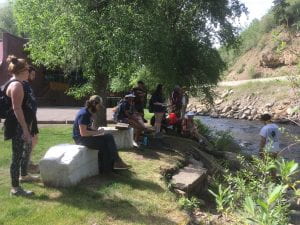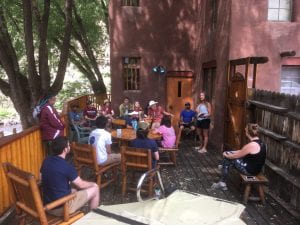
By: Chris Pryor
9:00am 06/18/2021
We began our first day of Colorado field adventures with outstanding sourdough pancakes made by our wonderful program administrator, Meagan McKellar. These pancakes -and several cups of coffee- served as fuel for many of us as we learned about surface water processes throughout the day!
Question: What are your expectations for the day?
Neel: “I want to be able to learn about the watershed processes as well as look at the river chemistry. I’m also interested in measuring the velocity of the flowing water and learning about the environmental issues facing the Eagle River.”
Chris: “Today I expect to learn about how critical river systems and watersheds are to the global environment, in respect to both sediment transport and nutrient cycling. I hope to also understand more about how the Eagle River Watershed Council manages water quality parameters in the dynamic conditions of Colorado.”
Liz: “Today I expect to learn more about water flow as it pertains to rivers and river systems, as well as its chemistry and pH levels. I also expect to learn more about mapping and applying these skills directly in the field.”
Our first stop was located right outside our hotel on the banks of the Eagle River, a 60-mile-long tributary of the Colorado River. Being our first field stop, we took a few moments to learn the basics of taking field notes. Dr. Mark Torres led the discussion about river morphology, geometry, and what important aspects of the river to take notes on. Concepts such as the river width, depth, and flow velocity seemed straightforward. Yet it was a new experience for many of us to apply these concepts to flood predictions, changes in river morphology, and how humans interact with surface water systems for infrastructure and water-supply needs.

We moved on to our second location along the Eagle River, slightly upstream from the hotel. This section of the river revealed different amounts of erosion on each side due to varying flow velocities. Here we discussed the different erosion and sediment transport patterns within this section of the stream. To test the velocity of the river we set up an experiment using a timer, tape measure and orange peels. We decided to perform 3 trials at the low flow velocity side of the river and then another 3 trials on the high flow velocity side. Kayla and I threw in the orange peels, while the rest of the team waited at the end of our measured distance to record the time when the orange peels ‘crossed the finish line.’ Not only was this a fun experiment, but it also gave us all an excuse to eat oranges – which is never a bad idea!

When we arrived back to the hotel, we were warmly greeted by Holly Loft – executive director of the Eagle River Watershed Council (ERWC). Holly came to discuss how her nonprofit organization works to mediate [with whom?] environmental issues facing the watershed and advocates for the health of the Eagle River, its tributaries, and the surrounding communities. Through Holly’s talk, we learned about the complex regional water rights policies for Colorado, the effect of climate change and population growth on the watershed, issues regarding storm water runoff systems, management of old acid mine drainage, while balancing the needs of all stakeholders when attempting to resolve environmental issues. Holly’s presentation effectively conveyed to everyone that organizations such as the ERWC, and environmental advocates such as Holly, are vital to maintaining healthy water supplies and ecosystems. Our conversations of environmental advocacy and water rights carried on into lunch, as so many of us were interested in how water is such a vital resource. From our entire cohort, thank you for coming Holly!

After lunch we went back in the field to Cross Creek, a tributary of the Eagle River. Grad student Will Larsen led the discussion alongside Dr. Mark Torres about river chemistry, United States Geological Survey (USGS) discharge stations, and the water-mass balance of the Colorado hydrologic cycle. Here we were to perform hands-on work involving river chemistry and geometry. First, we learned proper river water sampling techniques for water isotopes and metals. Then, Liz and I then put on waders to get in the water and estimate the max depth of the river. Grad student Jackson Borchardt spotted a tree branch that had been stripped bare by a beaver, so naturally we agreed that this was the ideal way to measure the depth!


As we headed back to the van, our program director (and on-call soil scientist), Dr. Carrie Masiello, discussed how we went “back in time” as we moved away from the riparian zone – the area adjacent to rivers and streams. Large trees and aquatic plants surrounded the riverbanks, while shrubs and smaller vascular plants thrived further out. Beyond the shrubs was the star of the show – the biocrust! Biocrust ensures healthy development of soil, prevents erosion, and sets the foundation for vascular plants to develop in arid regions, like Colorado. In other words, biocrust is essential to planetary habitability! Dr. Masiello was able to discuss the importance of Microcoleus, a genus of cyanobacteria, within the biocrust and how the microbes, moss, and lichen interact in this community. It was so intriguing to see such distinct changes in the vegetation and microbial communities.


We concluded our day with a scenic hike up Notch Mountain Road, both for leisure and to reflect on all we had learned that day. Upon arriving back to the hotel, Zach and Neel made a delicious taco bar for dinner!

Question: What did you learn today?
Janae: “Today I learned what to look for when it comes to taking field notes. The first time practicing this was when we went to the Eagle River and discussed some of the river’s characteristics such as its width, depth, cross-sectional area, velocity, etc. We were able to practice calculating the velocity of the river in certain areas during the orange activity and it was very interesting how different parts of the river had completely different velocities. Later in the day, we also learned about how to properly take samples without contaminating it and learned about glaciers for our trip tomorrow.”
Zach: “Not only did I learn some basic concepts in hydrology, but I also improved my skill at taking field notes and thinking about my surroundings from a more comprehensive scientific perspective. I also loved listening to Holly’s talk, especially because it helped me frame water in an environmental justice standpoint and realize why water is such a huge deal in areas that don’t receive as much rain as where I am from. The whole idea of water rights blew my mind — and I will definitely need to keep refining my ideas about these topics moving forwards.”
Trinity: “Today my favorite thing I learned is how rivers are measured in terms of flooding impacting the width, depth, and velocity of the water. I liked learning about the physics of water flow and curving rivers. I also enjoyed throwing oranges into the river to calculate velocity as well as taking water samples.”
